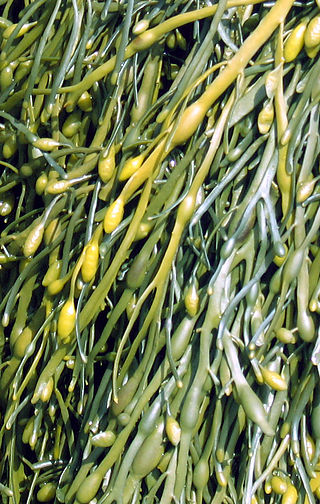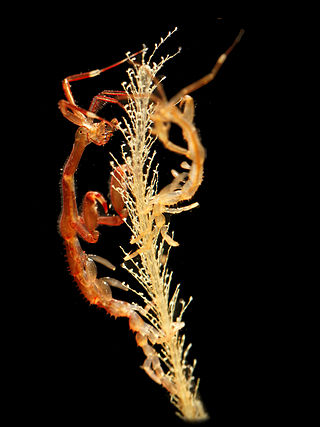
An invasive species is an introduced species that harms its new environment. Invasive species adversely affect habitats and bioregions, causing ecological, environmental, and/or economic damage. The term can also be used for native species that become harmful to their native environment after human alterations to its food web. Since the 20th century, invasive species have become serious economic, social, and environmental threats worldwide.

The Gulf of Maine is a large gulf of the Atlantic Ocean on the east coast of North America. It is bounded by Cape Cod at the eastern tip of Massachusetts in the southwest and by Cape Sable Island at the southern tip of Nova Scotia in the northeast. The gulf includes the entire coastlines of the U.S. states of New Hampshire and Maine, as well as Massachusetts north of Cape Cod, and the southern and western coastlines of the Canadian provinces of New Brunswick and Nova Scotia, respectively.

The Florida Keys National Marine Sanctuary is a U.S. National Marine Sanctuary in the Florida Keys. It includes the Florida Reef, the only barrier coral reef in North America and the third-largest coral barrier reef in the world. It also has extensive mangrove forest and seagrass fields. The Florida Keys National Marine Sanctuary, designated on December 28, 1990, was the ninth national marine sanctuary to be established. The Florida Keys National Marine Sanctuary protects approximately 2,900 square nautical miles of coastal and ocean waters from the estuarine waters of South Florida along the Florida Keys archipelago and the Hawk Channel passage, encompassing more than 1,700 islands, out to the Dry Tortugas National Park, reaching into the Atlantic Ocean, Florida Bay, and the Gulf of Mexico.

The round goby is a euryhaline bottom-dwelling species of fish of the family Gobiidae. It is native to Central Eurasia, including the Black Sea and the Caspian Sea. Round gobies have established large non-native populations in the Baltic Sea, several major Eurasian rivers, and the North American Great Lakes.

Ascophyllum nodosum is a large, common cold water seaweed or brown alga (Phaeophyceae) in the family Fucaceae. Its common names include knotted wrack, egg wrack, feamainn bhuí, rockweed, knotted kelp and Norwegian kelp. It grows only in the northern Atlantic Ocean, along the north-western coast of Europe including east Greenland and the north-eastern coast of North America. Its range further south of these latitudes is limited by warmer ocean waters. It dominates the intertidal zone. Ascophyllum nodosum has been used numerous times in scientific research and has even been found to benefit humans through consumption.

Carcinus maenas is a common littoral crab. It is known by different names around the world. In the British Isles, it is generally referred to as the shore crab, or green shore crab. In North America and South Africa, it bears the name European green crab.

Rapana venosa, common name the veined rapa whelk or Asian rapa whelk, is a species of large predatory sea snail, a marine gastropod mollusc or whelk, in the family Muricidae, the rock shells.

The Lessepsian migration is the migration of marine species along the Suez Canal, usually from the Red Sea to the Mediterranean Sea, and more rarely in the opposite direction. When the canal was completed in 1869, fish, crustaceans, mollusks, and other marine animals and plants were exposed to an artificial passage between the two naturally separate bodies of water, and cross-contamination was made possible between formerly isolated ecosystems. The phenomenon is still occurring today. It is named after Ferdinand de Lesseps, the French diplomat in charge of the canal's construction. The term was coined by Francis Dov Por in his 1978 book.

Symsagittifera roscoffensis, also called the Roscoff worm, the mint-sauce worm, or the shilly-shally worm, is a marine acoel worm. The origin and nature of the green color of this worm stimulated the intrigued zoologists in the 1870's. It was discovered that the coloring resulted from the symbiosis between the animal and a green micro-algae, the species Tetraselmis convolutae, hosted under its epidermis. It is the photosynthetic activity of the micro-algae in hospite that provides the essential nutrients for the worm. This partnership is called photosymbiosis, from "photo", "light", and symbiosis "who lives with". These photosynthetic marine animals live in colonies on the tidal zone.
Throughout much of the tropics, tilapiine cichlids native to Africa and the Levant have been widely introduced into a variety of aquatic systems. In the U.S. states of Florida and Texas, tilapia were originally introduced to curtail invasive plants. In an effort to meet the growing demand for tilapia, humans have farmed these fish in countries around the world. Capable of establishing themselves into new ponds and waterways, many tilapia have escaped aquaculture facilities across much of Asia, Africa, and South America. In other cases, tilapia have been established into new aquatic habitats via aquarists or ornamental fish farmers.

Hemigrapsus sanguineus, the Japanese shore crab or Asian shore crab, is a species of crab from East Asia. It has been introduced to several other regions, and is now an invasive species in North America and Europe. It was introduced to these regions by ships from Asia emptying their ballast tanks in coastal waters.

Platydemus manokwari, also known as the New Guinea flatworm, is a species of large predatory land flatworm.
In ecology, species homogeneity is a lack of biodiversity. Species richness is the fundamental unit in which to assess the homogeneity of an environment. Therefore, any reduction in species richness, especially endemic species, could be argued as advocating the production of a homogeneous environment.

Caprella mutica, commonly known as the Japanese skeleton shrimp, is a species of skeleton shrimp. They are relatively large caprellids, reaching a maximum length of 50 mm (2.0 in). They are sexually dimorphic, with the males usually being much larger than the females. They are characterized by their "hairy" first and second thoracic segments and the rows of spines on their bodies. Body color ranges from green to red to blue, depending on the environment. They are omnivorous highly adaptable opportunistic feeders. In turn, they provide a valuable food source for fish, crabs, and other larger predators. They are usually found in dense colonies attached to submerged man-made structures, floating seaweed, and other organisms.

Pterois is a genus of venomous marine fish, commonly known as the lionfish, native to the Indo-Pacific. It is characterized by conspicuous warning coloration with red or black bands, and ostentatious dorsal fins tipped with venomous spines. Pterois radiata, Pterois volitans, and Pterois miles are the most commonly studied species in the genus. Pterois species are popular aquarium fish. P. volitans and P. miles are recent and significant invasive species in the west Atlantic, Caribbean Sea and Mediterranean Sea.

Platydemus manokwari, also known as the New Guinea flatworm, is a large predatory land flatworm that has become an invasive species in many countries.

Alien species, or species that are not native, invade habitats and alter ecosystems around the world. Invasive species are only considered invasive if they are able to survive and sustain themselves in their new environment. A habitat and the environment around it has natural flaws that make them vulnerable to invasive species. The level of vulnerability of a habitat to invasions from outside species is defined as its invasibility. One must be careful not to get this confused with invasiveness, which relates to the species itself and its ability to invade an ecosystem.
Otomesostoma auditivum is a free-living, hermaphroditic flatworm in the order Proseriata, found in brackish and freshwater environments. It is a palearctic species living in shallow-water coastal habitats, and occurring in some freshwater lakes far from the sea.

Climate change and invasive species refers to the process of the environmental destabilization caused by climate change. This environmental change facilitates the spread of invasive species — species that are not historically found in a certain region, and often bring about a negative impact to that region's native species. This complex relationship is notable because climate change and invasive species are also considered by the USDA to be two of the top four causes of global biodiversity loss.
Grateloupia turuturu, commonly called the devil's tongue weed, is a marine species of Rhodophyta, a type of seaweed, native to East Asia and parts of eastern Russia. Due to global shipping and maritime activities, G. turuturu has become an invasive species that has altered natural communities by out-competing native seaweed species; this has resulted in habitat loss in many parts of the world, primarily in Australia, Northern Ireland, Great Britain, and the northeastern United States. Other common names for this species are the "red menace" and "red tide".
















